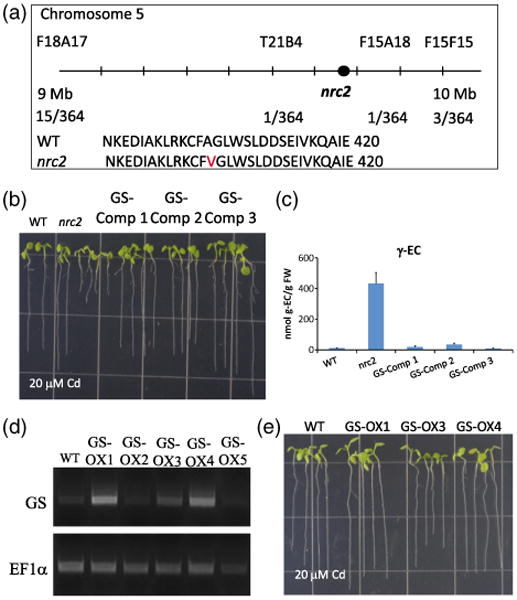Figure 5.

Characterization of the nrc2 non-response to the cadmium mutant as a first recessive viable allele in the Arabidopsis glutathione synthetase gene.
(a) Physical mapping of the nrc2 mutant placed the mutation on chromosome 5, between the F18A17 and F15F15 markers. Candidate gene sequencing identified a point mutation in At5g23780, which causes an Ala → Val (A404V) change in the glutathione synthetase protein.
(b) Expression of genomic GS in the nrc2 mutant behind a constitutive promoter restores root elongation on Cd. Three independent T2 transfor-mants (GS Comp1–Comp3) were used for root elongation experiments on 20 μm Cd.
(c) Seven-day-old complementation lines (GS Comp1–Comp3) were also used for fluorescence HPLC-MS analyses following 48 h of 100 μm Cd treatment. Gamma-glutamylcysteine (γ-EC) levels in the nrc2 mutant are approximately 50-fold higher than in the WT (431.7 ± 72.7 nmol per g fresh weight in nrc2 compared with 8.57 ± 0.25 nmol per g fresh weight in WT), whereas all three of the GS Comp lines show a WT γ-EC accumulation.
(d) The same genomic GS construct was also used to transform WT Col-0 plants to produce GS overexpression lines (GS OX1-OX5). RT-PCR of the GS gene was performed on T2 seedlings to identify lines expressing increased GS transcript levels compared with WT.
(e) T2 GS overexpression lines (GS-OX1, GS-OX3 and GS-OX4) were then used for root elongation experiments to show that extopic GS expression does not increases tolerance to 20 μm Cd. All bar graphs show the mean values from between three and six independent samples. Error bars represent the standard error of the mean (SEM).
